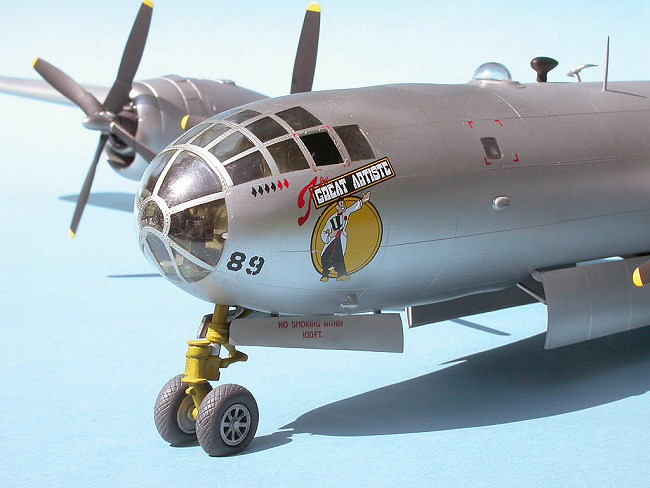
Monogram 1/48 B-29 Superfortress
| KIT: | |
| KIT #: | 5700 |
| PRICE: | $43.98 MSRP |
| DECALS: | Two options |
| REVIEWER: | Lee Kolosna |
| NOTES: | True Details resin wheels used. |

| HISTORY |
Ironically, General Curtis LeMay, who was brought in from Europe to head the XX Bomber Command in India and later XXI Bomber Command in the Marianas, directed a radical change in tactics after the initial poor results of the B-29 to perform as originally designed as a high altitude bomber. First, he stripped the bombers of all defensive armament except for two .50 caliber guns in the tail. This lightened the aircraft, allowing more bombs to be carried. He changed the bomb load to mostly incendiary devices which the B-29s dropped from low altitudes (5000 feet or so), which they did at night. Bomb Damage Assessment photos from the early traditional precision daylight bombing missions had shown that Japanese war industry was quite dispersed throughout urban areas, so LeMay postulated that the best way to disrupt it was through area bombing. B-29s based at Saipan and Tinian were allowed to fly directly to the target without having to gather up in formations and climb to high altitudes, which saved on fuel and reduced the incidence of engine overheating. The fact that Japanese buildings were constructed mostly of wood added to the efficacy of fires started by the incendiary bombs, giving rise to the most ghastly of modern wartime horrors, the firestorm. It was the true embodiment of US Civil War general William Tecumseh Sherman’s notion of Total War, as Japan’s major cities were literally burnt to the ground.
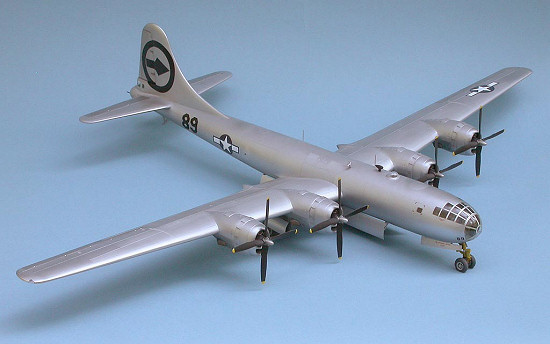
Colonel Tibbets himself led the mission of August 6, 1945 to Hiroshima, where the Little Boy atomic bomb was dropped successfully. He selected aircraft Victor-82, which belonged to pilot Robert Lewis, for the mission. Tibbets grabbed a sign painter and had the name of his mother, Enola Gay, painted on the side of the aircraft. When Capt. Lewis saw the nose art (the only Silverplate bomber to have any artwork applied before the end of the war), he was miffed. Tibbets reminded Lewis of the chain of command, and Enola Gay would forever be known as Tibbet’s personal aircraft. Lewis flew on the mission as the co-pilot. The other markings change made was the removal of the 509th’s tail markings of a large arrowhead inside a circle, which was replaced with tail markings of other units that regularly flew missions over Japan, hoping to blend in and avoid the suspicion of Japanese spotters. Enola Gay got a circle-R, used by B-29s from the 313th Bomber Wing. Others (Bockscar, for one) got a triangle-N, normal used by the 58th Bomber Wing.
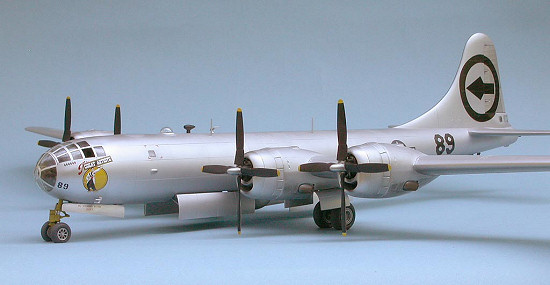 As soon as Enola Gay returned safely to Tinian,
President Truman announced to the world that a new, terrible bomb had been
deployed and that Japan should accept the terms of surrender that were
formulated by the Allied leaders at the recent Potsdam Conference. Not hearing
back through official channels, a second mission was ordered three days later.
While the first atomic mission was executed flawlessly, a number of things went
wrong on the second. First, the primary strike aircraft was supposed to be
The Great Artiste, but it was still loaded with scientific measuring gear
from the Hiroshima mission. Colonel Tibbets selected Bockscar instead,
even though he knew that the fuel transfer pump was broken on the 600 gallon
“Tokyo” tank in the rear bomb bay, thereby limiting its potential range. 393rd
Bomb Squadron commander Major Charles Sweeney was the mission leader, and the
crew that normally flew aboard The Great Artiste went with him aboard
Bockscar. Bockscar’s commander, Fred Bock, flew with his crew on
The Great Artiste. The Fat Man nuclear device was loaded aboard the
aircraft on August 9 and set off for the primary target of Kokura. A typhoon in
the area forced Bockscar and the rest of bombers in the strike force to
meet up at a different rendezvous point. The Great Artiste (scientific
monitoring) and Bockscar found each other quickly, but they never did
spot Up and Atom (photography) because of a misunderstanding about what
altitude to meet at and wasted a considerable amount of fuel waiting for each
other. The three bombers eventually met up over Kokura itself, but found that
that the city was obscured by clouds and smoke from a bombing mission B-29s had
done the day before on the nearby town of Yawata. After three bomb runs, the
bombardier failed to acquire the target in his sight so Sweeny elected to
proceed to the secondary target of Nagasaki. Once there, they again encountered
weather conditions that prevented clear visibility of the aiming point. Running
low on fuel and with strict orders to drop the device only with visual methods
the mission was in danger of being scrubbed, but the bombardier announced at the
last second that he thought he had acquired the target and the bomb was released
through a clearing in the clouds. It actually missed by miles, thereby sparing
the lives of tens of thousands of Japanese civilians, although 35,000 still died
almost instantly.
As soon as Enola Gay returned safely to Tinian,
President Truman announced to the world that a new, terrible bomb had been
deployed and that Japan should accept the terms of surrender that were
formulated by the Allied leaders at the recent Potsdam Conference. Not hearing
back through official channels, a second mission was ordered three days later.
While the first atomic mission was executed flawlessly, a number of things went
wrong on the second. First, the primary strike aircraft was supposed to be
The Great Artiste, but it was still loaded with scientific measuring gear
from the Hiroshima mission. Colonel Tibbets selected Bockscar instead,
even though he knew that the fuel transfer pump was broken on the 600 gallon
“Tokyo” tank in the rear bomb bay, thereby limiting its potential range. 393rd
Bomb Squadron commander Major Charles Sweeney was the mission leader, and the
crew that normally flew aboard The Great Artiste went with him aboard
Bockscar. Bockscar’s commander, Fred Bock, flew with his crew on
The Great Artiste. The Fat Man nuclear device was loaded aboard the
aircraft on August 9 and set off for the primary target of Kokura. A typhoon in
the area forced Bockscar and the rest of bombers in the strike force to
meet up at a different rendezvous point. The Great Artiste (scientific
monitoring) and Bockscar found each other quickly, but they never did
spot Up and Atom (photography) because of a misunderstanding about what
altitude to meet at and wasted a considerable amount of fuel waiting for each
other. The three bombers eventually met up over Kokura itself, but found that
that the city was obscured by clouds and smoke from a bombing mission B-29s had
done the day before on the nearby town of Yawata. After three bomb runs, the
bombardier failed to acquire the target in his sight so Sweeny elected to
proceed to the secondary target of Nagasaki. Once there, they again encountered
weather conditions that prevented clear visibility of the aiming point. Running
low on fuel and with strict orders to drop the device only with visual methods
the mission was in danger of being scrubbed, but the bombardier announced at the
last second that he thought he had acquired the target and the bomb was released
through a clearing in the clouds. It actually missed by miles, thereby sparing
the lives of tens of thousands of Japanese civilians, although 35,000 still died
almost instantly.
Upon release of the bomb, the three bombers
did an immediate 155 degree maximum-G diving turn to put as much distance
between them and the blast as possible. Because of the critical fuel situation,
Sweeny diverted to Okinawa and was convinced that he would have to ditch in the
ocean before reaching the airbase there. He was doubly concerned when he
discovered that all the search and rescue ships and aircraft had been recalled
because they were erroneously informed that the Kokura mission had b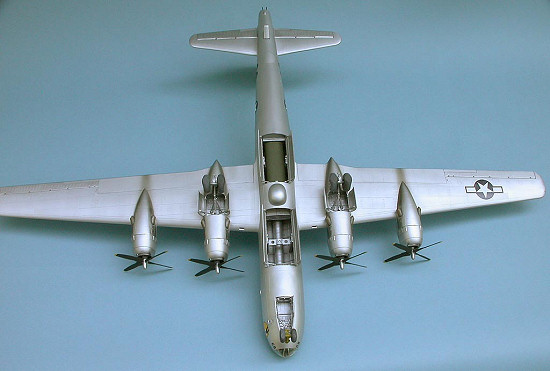 een
scrapped. Flying as efficiently as possible, Bockscar finally arrived
over Okinawa and requested permission to land, which was ignored by the tower
because there was an alert in progress. Firing off flares, Sweeny inserted his
aircraft into the landing pattern and started his final approach when engine
number 3 quit from fuel starvation. Right as the aircraft touched ground,
engine number 2 quit, leaving only two engines to slow the aircraft down before
leaving the end of the runway. Fortunately, the Silverplate reverse thurst
capabilities were utilized to the max and the plane stopped in time. Upon shut
down, it was determined that only 33 gallons of fuel remained aboard, excluding
the 600 gallons in the inaccessible Tokyo tank in the rear bomb bay. After
refueling at Okinawa, Bockscar flew back to Tinian and the mission was
over.
een
scrapped. Flying as efficiently as possible, Bockscar finally arrived
over Okinawa and requested permission to land, which was ignored by the tower
because there was an alert in progress. Firing off flares, Sweeny inserted his
aircraft into the landing pattern and started his final approach when engine
number 3 quit from fuel starvation. Right as the aircraft touched ground,
engine number 2 quit, leaving only two engines to slow the aircraft down before
leaving the end of the runway. Fortunately, the Silverplate reverse thurst
capabilities were utilized to the max and the plane stopped in time. Upon shut
down, it was determined that only 33 gallons of fuel remained aboard, excluding
the 600 gallons in the inaccessible Tokyo tank in the rear bomb bay. After
refueling at Okinawa, Bockscar flew back to Tinian and the mission was
over.
The second bombing convinced Emperor Hirohito to personally intervene and override the military leaders. He conducted a radio broadcast that contended that Japan had lost the war and could not continue. It was the first time in history that the general population had heard his voice. While historians and scholars still debate over the necessity of the use of atomic weapons, there is no doubt that the dropping of the two bombs forced the issue and brought to an end the most deadly conflict in human history.
More Silverplate B-29s were constructed in the following year to become the backbone of the United States’ atomic fleet. These were eventually replaced by B-36 and B-50 bombers as the Strategic Air Command was established. Bockscar is on display at the US Air Force museum in Dayton Ohio, and Enola Gay now sits in the Udvar-Hazy Center outside of Washington DC.
| THE KIT |
 , effectively
covering almost all of the major variants of all the US bombers of World War
II. Like other Monogram kits of this vintage, the B-29 features a very nicely
detailed interior complete from the nose cockpit section through the bomb bays
and all the way back to the crew bunks in the aft fuselage. Molded in silver
and black styrene with raised panel lines, the kit features twelve conventional
1000 LB bombs, replicas of the Fat Man and Little Boy atomic bombs, a bomb cart,
and several ground crew figures.
, effectively
covering almost all of the major variants of all the US bombers of World War
II. Like other Monogram kits of this vintage, the B-29 features a very nicely
detailed interior complete from the nose cockpit section through the bomb bays
and all the way back to the crew bunks in the aft fuselage. Molded in silver
and black styrene with raised panel lines, the kit features twelve conventional
1000 LB bombs, replicas of the Fat Man and Little Boy atomic bombs, a bomb cart,
and several ground crew figures.
Acknowledging the differences between a regular B-29 and a Silverplate bomber, large plugs are provided for use in sealing off the turrets and observation blisters, though the solution is an awkward and ultimately unsatisfactory for anyone wishing to make an accurate replica of Enola Gay or Bockscar. The problem is that the kit plugs only sit on top of the fuselage, whereas in reality they are flush with the aircraft’s skin. Another accuracy issue with the kit is that the propellers are of the Curtiss Electric variety, which is correct for nearly all of the Silverplate aircraft, but incorrect for the overwhelming majority of regular B-29s, which used Hamilton Standard props exclusively. It took nearly thirty years, but Revell-Monogram recently reissued the kit (5711) with a new sprue that includes the HS props. Modelers rejoiced in knowing that they no longer have to purchase expensive and long out-of-production resin replacements.
From an overall shape point of view, the kit looks
quite good, although our friends at Cutting Edge now provide a “significantly
improved” set of resin cowlings to replace the kit ones which are slightly
incorrect in shape. It is a personal decision as to whether you think the
replacement cowlings are worth the not inconsiderable price. One thing I do not
like about the kit cowlings is that they attach to the nace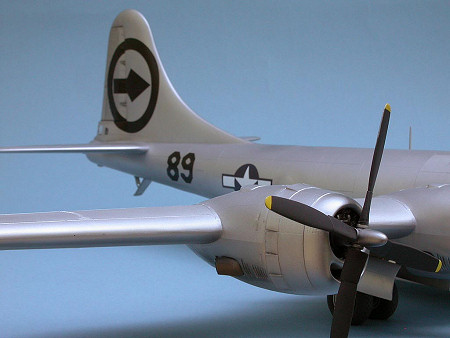 lle with a simple
butt join, which provides no alignment locating tabs or anything to reinforce
the joint. Cutting Edge also offers a conversion set of resin pieces that allow
for a less painful and accurate elimination of the turret and gun sight openings
for a Silverplate bomber. A minor issue is that the fabric texture of the
control surfaces is way overdone and could use a good sanding to restore it to
the properly smooth appearance of doped linen. The kit provides the 20mm tail
cannon seen in early B-29s, but the modeler will have to modify the canvas
covering on the tail turret if the model is depicted with the more common twin
.50 caliber machine gun configuration.
lle with a simple
butt join, which provides no alignment locating tabs or anything to reinforce
the joint. Cutting Edge also offers a conversion set of resin pieces that allow
for a less painful and accurate elimination of the turret and gun sight openings
for a Silverplate bomber. A minor issue is that the fabric texture of the
control surfaces is way overdone and could use a good sanding to restore it to
the properly smooth appearance of doped linen. The kit provides the 20mm tail
cannon seen in early B-29s, but the modeler will have to modify the canvas
covering on the tail turret if the model is depicted with the more common twin
.50 caliber machine gun configuration.
| CONSTRUCTION |
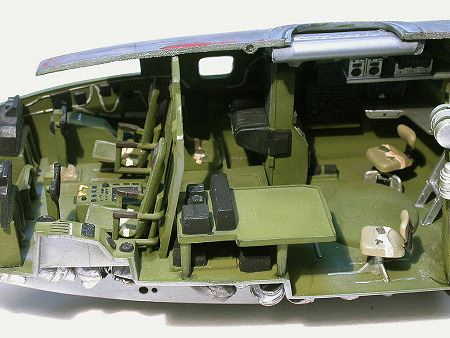
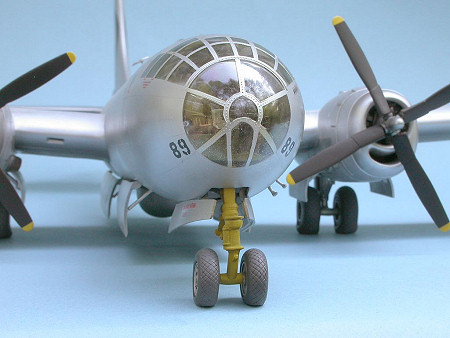 The wheel wells have a number of ejector
pin marks that were impossible to fill and sand with traditional methods, so I
cut pieces of thin sheet styrene and placed them over each of the pin mark
depressions. It hides it well enough. The large ejector pin marks on the bomb
bay and landing gear doors were much more labor intensive to fill with CA glue,
but a necessary task. The wing pieces were glued together, revealing huge gaps
on the sides of each of the four engine nacelles. I filled these gaps with
strips of sheet styrene and sanded them smooth. For the position lights on each
wingtip, I inserted a short length of stretched sprue in the corner and painted
it dark red (port) or dark blue (starboard) to replicate the unlit light bulb,
then faired in the clear cover. The Wright R-3350 engines were painted with Metalizer Steel with a dark gray crankcase and black pushrods, and then dirtied
up with a dark gray wash. The main landing struts were cleaned up and painted
with Floquil Old Silver. Note that period color photos of the nose landing gear
strut of Enola Gay, Bockscar, and a number of other B-29s (both
conventional and Silverplate) clearly show them to be painted only in yellow
zinc chromate primer. I asked retired NASM researcher Dana Bell about why
Enola Gay is now displayed at the Udvar-Hazy Center museum with an aluminum
lacquer nose strut, and he responded that it had originally been restored to
chromate yellow, but was “corrected” to aluminum when less accurate references
were introduced. It just goes to show you that even the big boys make mistakes
when it comes to paint colors. For my model, I painted the strut with Testors
Acryl Chromate Yellow.
The wheel wells have a number of ejector
pin marks that were impossible to fill and sand with traditional methods, so I
cut pieces of thin sheet styrene and placed them over each of the pin mark
depressions. It hides it well enough. The large ejector pin marks on the bomb
bay and landing gear doors were much more labor intensive to fill with CA glue,
but a necessary task. The wing pieces were glued together, revealing huge gaps
on the sides of each of the four engine nacelles. I filled these gaps with
strips of sheet styrene and sanded them smooth. For the position lights on each
wingtip, I inserted a short length of stretched sprue in the corner and painted
it dark red (port) or dark blue (starboard) to replicate the unlit light bulb,
then faired in the clear cover. The Wright R-3350 engines were painted with Metalizer Steel with a dark gray crankcase and black pushrods, and then dirtied
up with a dark gray wash. The main landing struts were cleaned up and painted
with Floquil Old Silver. Note that period color photos of the nose landing gear
strut of Enola Gay, Bockscar, and a number of other B-29s (both
conventional and Silverplate) clearly show them to be painted only in yellow
zinc chromate primer. I asked retired NASM researcher Dana Bell about why
Enola Gay is now displayed at the Udvar-Hazy Center museum with an aluminum
lacquer nose strut, and he responded that it had originally been restored to
chromate yellow, but was “corrected” to aluminum when less accurate references
were introduced. It just goes to show you that even the big boys make mistakes
when it comes to paint colors. For my model, I painted the strut with Testors
Acryl Chromate Yellow.
The vertical stabilizer in my kit was slightly off in alignment, so I bent it back after dipping the entire rear fuselage in a pot of nearly-boiling water for a few seconds. All of the clear parts were spot-glued to the fuselage pieces with liquid model cement, then faired in with CA glue and polished to restore clarity using a tri-grit file and Novus Plastic Polish #2. This gives a nice clean and flush look to each of the windows. The same was done for the main greenhouse canopy and the nosecap.
 I glued the wings and horizontal stabilizers on, being careful to
get everything in proper alignment. Typical of these Monogram bomber kits,
large gaps were left to be filled at the wing roots which I did with CA glue.
All the seams were primed with Mr. Surfacer 1000 to insure that any air bubbles
and ghost seams were filled. I restored the panel lines that had been
obliterated by the lengthy seam filling process using a sewing needle chucked in
a pin vise. The only observation bubble that remains on the airplane is located
directly located over the tunnel that runs through the bomb bay that connects
the two pressured compartment. I drilled a large hole in the top of the tunnel
piece and I boxed in the surrounding area with thin sheet styrene to give a more
realistic look to the position.
I glued the wings and horizontal stabilizers on, being careful to
get everything in proper alignment. Typical of these Monogram bomber kits,
large gaps were left to be filled at the wing roots which I did with CA glue.
All the seams were primed with Mr. Surfacer 1000 to insure that any air bubbles
and ghost seams were filled. I restored the panel lines that had been
obliterated by the lengthy seam filling process using a sewing needle chucked in
a pin vise. The only observation bubble that remains on the airplane is located
directly located over the tunnel that runs through the bomb bay that connects
the two pressured compartment. I drilled a large hole in the top of the tunnel
piece and I boxed in the surrounding area with thin sheet styrene to give a more
realistic look to the position.
Since this is a natural metal finish model, I had to go on a search and destroy mission to eliminate all the stray scratches and sanding marks. Being such a large airplane, this took quite a while to complete using worn 600 grit sandpaper and Novus Plastic Polish #3 and #2. Those of you that remember my Modeler’s Musings column of March 2006, it was at this point where the model fell off the kitchen counter, where I had briefly laid it down. The right wing was detached, half the fuselage split open, both horizontal stabilizers cracked, and the front turret fairing popped off. It took a while to recover, but I did, and it was time to paint this big model.
| COLORS & MARKINGS |
I've been using Alcald II Lacquer for a while now and have gotten
comfortable with the routine for using it to replicate a natural metal finish.
First, the model was primed with Floquil Old Silver enamel paint. This was
allowed to dry for a week. It revealed a few spots that needed to be addressed
by refilling a seam or eliminating a rough spot that I had missed on the first
go around. When that was done, I applied Alclad Polished Aluminum to the whole
model. This is the brightest of the Alclad shades
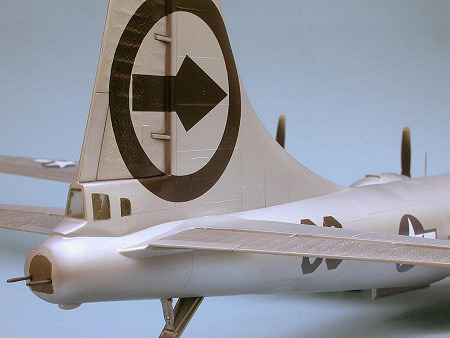 and was selected after
looking at a number of photographs of the B-29s on Tinian. These aircraft were
extremely well taken care and quite shiny, even in the harsh tropical sun and
coral dust conditions. After that dried for a day, I masked off the center
panels on both the top and bottom of both wings and shot a coat of Testors
Dullcote Lacquer. This represents the B-29’s use of an aluminum alloy in this
area for extra strength, which was painted with aluminum lacquer on the real
aircraft. The front of each cowling and all the control surfaces got a coat of
Alclad Duraluminum. The panel around each exhaust was painted with Alclad Dark
Aluminum. Finally, the plugs for the turrets and gunner observation stations
were painted with Testors Metalizer Aluminum Plate to make them stand out from
the rest of the fuselage, again as seen in photographs. I'm sorry this doesn't
show up better in the images of the model, but digital cameras seem to have a
hard time resolving silver objects. The effect in real life is much more
apparent.
and was selected after
looking at a number of photographs of the B-29s on Tinian. These aircraft were
extremely well taken care and quite shiny, even in the harsh tropical sun and
coral dust conditions. After that dried for a day, I masked off the center
panels on both the top and bottom of both wings and shot a coat of Testors
Dullcote Lacquer. This represents the B-29’s use of an aluminum alloy in this
area for extra strength, which was painted with aluminum lacquer on the real
aircraft. The front of each cowling and all the control surfaces got a coat of
Alclad Duraluminum. The panel around each exhaust was painted with Alclad Dark
Aluminum. Finally, the plugs for the turrets and gunner observation stations
were painted with Testors Metalizer Aluminum Plate to make them stand out from
the rest of the fuselage, again as seen in photographs. I'm sorry this doesn't
show up better in the images of the model, but digital cameras seem to have a
hard time resolving silver objects. The effect in real life is much more
apparent.
I elected to decorate my model with markings for The Great
Artiste as it appeared shortly after the war ended in September 1945. As
mentioned above, none of the Silverplate bombers save Enola Gay had any
nose art applied during the atomic missions. Also, the arrowhead in a circle
tail marking of the 509th was restored on all the aircraft when the
colorful nose art was applied. Decals came from Super Scale sheet 48-0935 and
went on beautifully. This is the second time Super Scale has put out a sheet
depicting this airplane. On the first sheet, the background of the nose artwork
is medium green. On the second sheet, it is yellow. Which is correct? Well,
the one color photo I have seen has been reproduced many times in various
publications, and none of the printings are consistent. My opinion is that it
was actually a very light green, but who really knows? I used the more recent
Super Scale rendition in yellow. I cut the black sections of the tail markings
away from their clear carrier and carefully applied them to the vertical
stabilizer. The national insignia came from AeroMaster sheet 48-271. After
drying, trapped air bubbles in the decals were pierced with the tip of an X-acto
knife blade and Micro Sol applied to get them to snuggle down. The AeroMaster
markings were tougher to tame, so I broke out the heavy gun
 Solvaset, which
finally whipped them into shape. I sprayed a very light mist coat of Future
floor polish over the entire model to help even out the sheen of the decals, but
I was disappointed in how it dulled down the shiny finish that I had worked so
hard to achieve. On my next model, I guess I’m going to have to apply the clear
varnish on just the decals themselves.
Solvaset, which
finally whipped them into shape. I sprayed a very light mist coat of Future
floor polish over the entire model to help even out the sheen of the decals, but
I was disappointed in how it dulled down the shiny finish that I had worked so
hard to achieve. On my next model, I guess I’m going to have to apply the clear
varnish on just the decals themselves.
Weathering was very lightly applied, with a dusting of pastels in the wheel wells and Tamiya Smoke was used for the exhaust staining underneath the wings. I used True Details resin wheels and tires, which are ridiculously under-inflated, but still have a nice tread pattern that is superior to the kit tires. The tires were weathered with a very thin spray of light gray.
For fun, I built and painted the two atomic bombs. The latest research shows that Little Boy was a gloss dark Olive Drab, rather than the dark blue seen so often in museum pieces. Monogram didn't get it quite right in that the antennae are present in four positions on the bomb, each ninety degrees from each other. The kit piece only has antennas in two places, so I fabricated new ones from stiff wire and added the bright red safety plugs. I also added “L11” from a decal lettering set. The Fat Man bomb was painted chromate yellow with a black sealant sprayed around the circumference of the nose and the equator. The fin structure of both bombs is simplistic compared to the real thing, but I didn't bother correcting that.
| FINAL CONSTRUCTION |
Despite my best attempts to keep water and dust from entering the
sealed up cockpit, I was surprised when I removed the masking from the canopy
greenhouse and discovered a less than pristine interior surface. My solution
was to drill out the pilot’s escape hatch from the canopy and swab the interior
with a Q-tip moistened with a little bit of Windex. Photos of B-29s on the
ground show that this hatch was often left open while the aircraft was parked,
probably to vent the stifling heat from the cockpit.
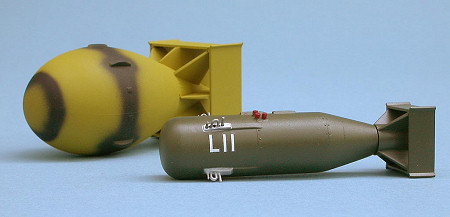
| CONCLUSIONS |
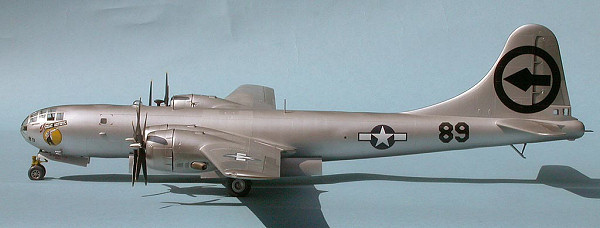 This is one big-ass model! Like all the other Monogram 1/48 scale
bombers, it probably resides in the back of more modeler’s closets unbuilt than
it does as a completed model on a display shelf. In all the years I've been
modeling, I've seen only one other built. That’s a shame because the visual
impact of such a large and shiny model is stunning and always draws a crowd of
enthusiastic viewers wherever it goes. It’s quite a challenging undertaking,
particularly if one is going to do a Silverplate bomber with its flush turret
plugs and observation window fairings. Those who are a little less adventurous
can get the recent reissue with Hamilton Standard props for a very reasonable
price and build the model using the kit or aftermarket decals in standard
conventional configuration with gun turrets in place. Fit is typical of
Monogram kits of the period so one should expect to do a lot of laborious seam
filling as well as be prepared for the effort to make a convincing natural metal
finish. I spent nearly 80 hours on my model, and pretty much enjoyed every
minute, other than the re-do after the big crash. This is a good model of a
very historically significant airplane, and I'm thankful for being able to have
one in my collection.
This is one big-ass model! Like all the other Monogram 1/48 scale
bombers, it probably resides in the back of more modeler’s closets unbuilt than
it does as a completed model on a display shelf. In all the years I've been
modeling, I've seen only one other built. That’s a shame because the visual
impact of such a large and shiny model is stunning and always draws a crowd of
enthusiastic viewers wherever it goes. It’s quite a challenging undertaking,
particularly if one is going to do a Silverplate bomber with its flush turret
plugs and observation window fairings. Those who are a little less adventurous
can get the recent reissue with Hamilton Standard props for a very reasonable
price and build the model using the kit or aftermarket decals in standard
conventional configuration with gun turrets in place. Fit is typical of
Monogram kits of the period so one should expect to do a lot of laborious seam
filling as well as be prepared for the effort to make a convincing natural metal
finish. I spent nearly 80 hours on my model, and pretty much enjoyed every
minute, other than the re-do after the big crash. This is a good model of a
very historically significant airplane, and I'm thankful for being able to have
one in my collection.
| REFERENCES |
Albury, Charles D. and James P Busha : “Bockscar’s Bash”, Flight Journal,
August 2005
Baugher, Joseph: B-29 Superfotress,
http://home.att.net/~jbaugher2/b29.html
Bell, Dana: discussion group postings about Enola Gay colors
Davis, Larry: B-29 Superfotress In Action
Pace, Steve and Dick Campbell: “The Silverplate B-29s, Worlds’ First Atomic
Bombers”, Wings, August 2002
Rhodes, Richard: The Making of the Atomic Bomb
May 2006
Copyright ModelingMadness.com
If you would like your product reviewed fairly and fairly quickly, please
contact
the editor or see other details in the
Note to
Contributors.